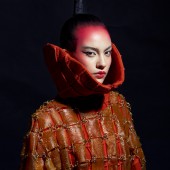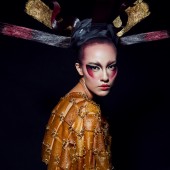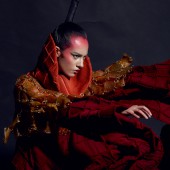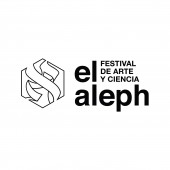Turandot Armor Costume by Cynthia Gomez |
Home > |
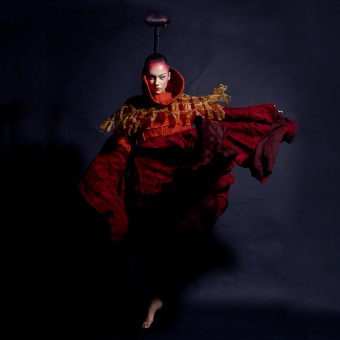 |
|
||||
| DESIGN DETAILS | |||||
| DESIGN NAME: Turandot Armor PRIMARY FUNCTION: Costume INSPIRATION: The costume is inspired by Giacomo Puccini's Turandot opera, which symbolizes the princess's self-confinement in the face of interpersonal relationships, which is why her face is covered with an immense neck that protects her from love. An Upcycling tecnique was used with the patch-working, reusing textile waste to give it a second life. In the same way, an armor made with substrate biomaterials from the orange waste, represents the sentimental barriers of Princess Turandot. UNIQUE PROPERTIES / PROJECT DESCRIPTION: In each production the costume industry generates pieces for each character and at the end these become obsolete because they can rarely be used again It was from this problem that this sustainable costume project emerged, which proposes the design of an operatic outfit using sustainable techniques such as upcycling and the creation of biomaterials made from orange waste The project seeks to reuse existing materials and develop new materials in order to counteract pollution in fashion OPERATION / FLOW / INTERACTION: is a costume so it can be exhibit in a display maniqui. PROJECT DURATION AND LOCATION: started en january 2022 in Mexico City and finished in july 2022 FITS BEST INTO CATEGORY: Fashion, Apparel and Garment Design |
PRODUCTION / REALIZATION TECHNOLOGY: For the armor, the circular economy theory was used, taking advantage of orange peel waste for the production of biomaterials, made with gelatin, glycerin and the orange substrate. The dress was made from reusing deadstock knitted fabric, using the quilting technique to generate the patches and color gradient in the piece, everything was handmade. SPECIFICATIONS / TECHNICAL PROPERTIES: the dress knitting mesure 80mm x 10mm x 180mm the armor biomaterial mesure 60 mm x 5mm x 50mm TAGS: biomaterial, upcycling, deadstock, sustainability, costume design RESEARCH ABSTRACT: We sought to impact the costume industry through sustainability and innovation, the piece was for an opera singer which implied movement and comfort. We use design thinking for our research, doing interviews, searching for sustainable materials and technology that would help us Regarding biomaterials we experimented with many fruit substrates up to orange peel, which has the best properties. As for the dress, we had many fittings to see the feasibility in terms of weight, structure and comfort so that she could perform. CHALLENGE: the hardest part of the design was the funcionality of the project, with the upcycling tecnique using knitting deadstock, and the elaboration of the formula with the orange sustrat in the biomaterial. ADDED DATE: 2024-03-06 03:53:49 TEAM MEMBERS (2) : and IMAGE CREDITS: Image #1: Opcional Image #1: Opcional Image #2: Opcional Image #3: Opcional Image #4: photographer Silvetre García, hairdesigner Ignazio Muñoz, makeup artist Enrique Santana Video Credits: Cynthia Gómez |
||||
| Visit the following page to learn more: https://www.cynthiagomez.mx/ | |||||
| SOCIAL |
| + Add to Likes / Favorites | Send to My Email | Comment | Testimonials | View Press-Release | Press Kit |
Did you like Cynthia Gomez's Costume Design?
You will most likely enjoy other award winning costume design as well.
Click here to view more Award Winning Costume Design.


